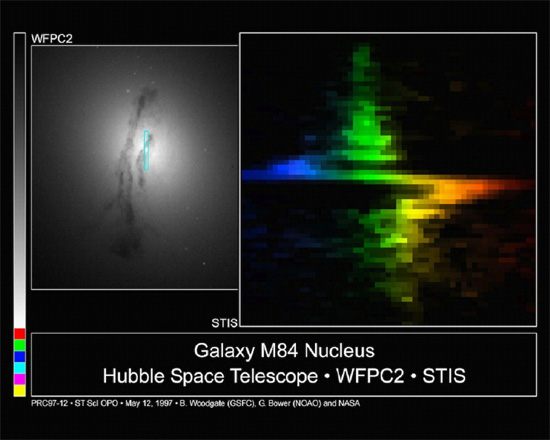|

Spectrum of galaxy M84 supposedly
indicating a black hole near its
center.
The Persistent Illusion
Jul 26, 2011
Does the acceleration of
gravity alone create high frequency
radiation?
"Greatness is a zigzag streak of
lightning in the brain."--- Herbert
Asquith, Prime Minister of the
United Kingdom, 1908-1916
Black holes are theoretically
required because velocity and
gravity calculations of motions at
the galactic center yield otherwise
impossible results. Matter inside a
black hole is said to be near
infinite density, with intense
gravitational attraction so great
that not even light can escape. They
are called "black" holes because
they cannot be detected with optical
telescopes. They are thought to
inhabit over 90% of the galaxies in
the Universe.
Previous Picture of the Day
discussions about black holes
determined that the descriptive
terms used by astronomers rely on
highly speculative explanations.
Ambiguous labels such as space/time,
singularities, infinite density and
other ideas that are unreal, make
what should be a scientific
investigation into the nature of the
Universe something of a nonsense.
According to a Hubble Space
Telescope
press release, galaxy M84
has provided NASA researchers with
"proof" that it harbors a Super
Massive Black Hole (SMBH) in its
core greater than 300 million times
the mass of our own Sun.
Using
spectrographic data from
the Hubble Space Telescope,
astronomers measured the rotational
velocity of dust and gas near the
center of M84. Since the
spectrogram's s-shaped graph seems
to show areas of more rapid rotation
(up to 1,400,000 kilometers per
hour), it was assumed that something
very compact in the galaxy's core
must be exerting a powerful
gravitational force.
Since galaxies are thought to be
self-powered, gravity-driven
engines, relying on kinetic energy
to operate, the fact that they do
not appear to supply enough energy
to hold themselves together required
space scientists to come up with two
major adjustments to their
cosmological theories: SMBHs and
dark matter. In this case, a black
hole's near-infinite mathematical
capacity to accelerate matter is
brought into play.
X-rays and other high frequency
radiation in space, no matter the
source, are not easily generated by
accelerating charge-neutral gas in
gravity fields. It is far easier for
charged particles (plasma)
accelerated by electric fields to
shine in all frequencies: extreme
ultraviolet, X-rays, and even gamma
rays.
In a
galactic circuit, electric power
flows inward along the spiral arms
where it is concentrated and stored
in the central plasmoid. When the
plasmoid reaches a threshold
density, it must decay and
discharge, along the galaxy’s spin
axis. This process can be
demonstrated in the laboratory using
a plasma focus device.
The discharge creates neutrons,
heavy ions, and electrons jetting
out from the nucleus.
Electromagnetic forces confine the
jet to thin filaments that remain
coherent for thousands of
light-years. The jet usually ends in
radio lobes on either side of the
galaxy, which radiate in radio
frequencies.
The cosmic Birkeland currents
that supply energy to galactic
plasmoids also provide rotational
energy by spinning around one
another. Electromagnetism
concentrates electric currents that
generate magnetic fields, increasing
current confinement forces, which
increases the magnetic field, and so
on. When those forces act on the
galactic scale, they might be
perceived in the unphysical way of
black holes.
Stephen Smith
Hat tip to Gilbert Eriksen
 New
DVD New
DVD
The Lightning-Scarred
Planet Mars
A video documentary that could
change everything you thought you
knew about ancient times and
symbols. In this second episode of
Symbols of an Alien Sky, David
Talbott takes the viewer on an
odyssey across the surface of Mars.
Exploring feature after feature of
the planet, he finds that only
electric arcs could produce the
observed patterns. The high
resolution images reveal massive
channels and gouges, great mounds,
and crater chains, none finding an
explanation in traditional geology,
but all matching the scars from
electric discharge experiments in
the laboratory. (Approximately 85
minutes)
Video Selections
Order Link
|





 New
DVD
New
DVD

